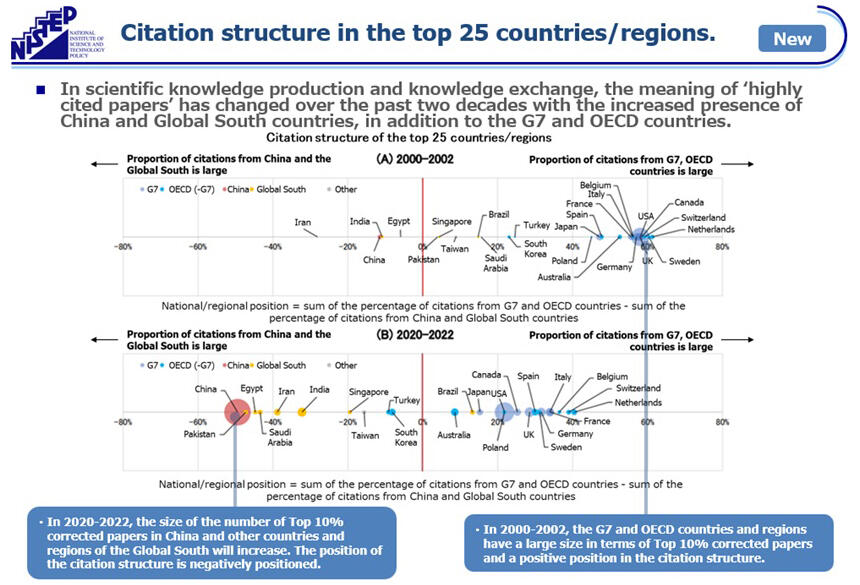The National Institute of Science and Technology Policy (NISTEP) has released its Science and Technology Indicators 2024. The data reveal that the world of scientific research is divided into two major camps. The indicators analyzed citation patterns in the 25 countries/regions with highest numbers of "top 10% papers" (highly cited papers). The top 10% papers were found to fall into two broad groups, one with a large percentage of citations from G7 and OECD countries and the other from China and Global South countries. Japan is in the G7 and similar forums, therefore, it has relatively high numbers of citations from the U.S. On this count alone, its world ranking rises from 13th to ninth.

(Source) Prepared by Science Japan based on the 'Science and Technology Indicators 2024,' prepared by the National Institute of Science and Technology Policy (NISTEP), Ministry of Education, Culture, Sports, Science and Technology.
The Science and Technology Indicators are basic data for systematically understanding Japan's science and technology activities. They offer objective and quantitative data. They compare the situation in Japan and major countries on approximately 160 points. These are classified into five categories, namely, R&D expenditure, R&D personnel, Higher education and S&T personnel, Output of R&D, and Science, technology, and innovation.
Japan's combined industry−academia−government R&D expenditures are the third largest in the world. However, its university expenditure has been overtaken by the U.K. Furthermore, Japan, which was in fourth place last year, is now in fifth. Japan ranks third overall in the number of researchers. However, it has been overtaken by France in the number of public institutions, dropping from fourth to fifth place. On top of this, Japan ranked fifth in the number of papers (fractional count method) but 13th in the number of high-profile top 10% papers. It also ranked 12th in the number of top 1% papers. These are the same results as last year.
China ranks first in the world in all paper types. Looking at citation patterns for papers, the presence of China and the Global South has increased compared to 20 years ago. However, China has a high domestic citation rate of 62%. Approximately 70% of citations of papers from Iran, Egypt, Pakistan, and Saudi Arabia are from their own country, China, and the Global South. Changes in citation patterns indicate a fragmentation between "G7/OECD countries" and "China/Global South." This has resulted in the meaning of "highly cited papers" changing.
For example, China has a high citation rate in materials science, engineering, and chemistry. It may be building co-citation relationships with the Global South in such fields. Furthermore, India and Iran score higher than Japan in the regular citation rankings. However, they lose ground when top 10% papers are ranked by the number of citations from the U.S. Meanwhile, Japan moves up to ninth place.
However, the number of students enrolled in doctoral programs had been declining since its peak in Academic Year (AY) 2003. Nevertheless, the numbers increased by 4.4% in AY2023 compared to the previous year. The percentage of female students has been growing. As of AY2023, females accounted for 46% of undergraduate students, 31% of students in master's programs, and 34% of students in doctoral programs. The percentage in master's and doctoral programs has approximately doubled compared to AY1990.
Spending on joint research undertaken by Japanese universities and private companies has been continuously increasing. The figure for AY2022 was 100-billion-yen, funding 31,000 research projects. Moreover, the ratio of indirect expenses to direct expenses has increased. Comparing AY2006 with AY2022, the ratio increased from 8.5% to 24.5% for joint research. For funded research, it increased from {1>10.1%<1} to 19.6%. The number of university-launched venture companies has increased, reaching 4,288 in AY2023. This is 2.5 times the number for AY2014.
Japan ranks first in the world in the number of patent families (the same patent application filed with two or more countries). However, the percentage of patent applications citing an academic paper is 6.7%, which is lower than in Europe and North America (average of 20% plus). However, the percentage of Japanese papers cited in technology papers worldwide is 3.2%, which is approximately the world average. The number of alternative energy patent families (useful for the development of electric vehicles) has continued to grow since the late 1990s. It surpassed the number of patent families (useful for conventional gasoline engines) in 2018, reaching 4,519 in 2019. The alternative energy patent families have a higher percentage of citing an academic paper (7.2%) than the conventional gasoline type (1.5%).
This article has been translated by JST with permission from The Science News Ltd. (https://sci-news.co.jp/). Unauthorized reproduction of the article and photographs is prohibited.




